Product specification or Customer Requirements
Product specifications or customer requirements allow defining requirements related to ingredients.
For example:
- salt must be less than 2%;
- eggs of German origin are forbidden;
- rules on ingredient labeling;
- E171 is a forbidden ingredient in France
*Creating a product specification
In the developing product site, product spaces:
Click on create then product specifications.

Your "product specifications" entity is created, several lists are available, as on the entity lists.

- Properties: Name your product specifications, indicate the regulatory code, describe the product specifications, define a compatibility filter, associate another product specifications with your product specifications (examples: specificity related to a distribution country, specificity related to an activity...). For example, you create a product specifications for France and link it to an anti-doping product specifications. It is also possible to indicate the regulatory country associated with the product specifications as well as the regulatory uses provided by the product specifications.

Documents: Import your documents and link them to your product specifications.
Allergens: Add forbidden allergens (example: gluten)
Nutrients: Add a nutrient (example: sodium)
Claims: Add a claim (example: halal, kosher)
Physicochemical: Assign physico-chemical characteristics to the product specifications (example: density, biological origin)
Forbidden Ingredients: Create alerts (prohibition, tolerance...) to signal if you use any of the ingredients listed in the product specifications.
Labeling Rules: Create specific labeling rules. (example for a client: BtoB, BtoC, Retail...)
product specifications are automatically reformulated every day at 11 PM, otherwise formulate the product.
Allergens
From the allergen list, add the forbidden allergen and its threshold value then save. (example: gluten greater than 5%)

Press "Save" to save your form.
If the product associated with the product specifications contains the allergen significantly above the allowed quantity in the product specifications, an alert appears in the allergen list for the concerned allergen.
An alert is also issued in the progress wheel. 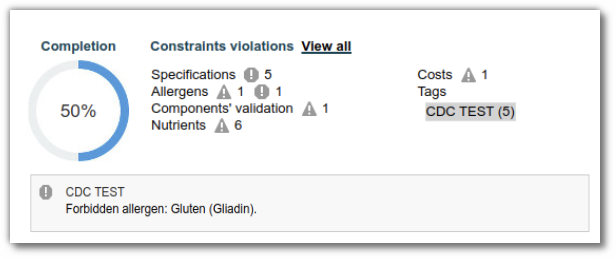
Nutrients
From the nutrient list, add the nutrient to specify and its threshold value then save. (example: sodium greater than 25mg)

Press "Save" to save your form.
If the product associated with the product specifications contains the nutrient significantly above the allowed quantity in the product specifications, an alert appears in the nutrient list for the concerned nutrient.
An alert is also issued in the progress wheel. 
Claims
From the claims list, add the agreed claim and its value then save. (example: kosher)
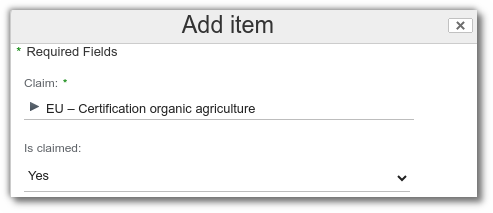
Press "Save" to save your form.
If the product associated with the product specifications is not organic, an alert appears in the claims list for the concerned claim.
An alert is also issued in the progress wheel. 
Physicochemical
From the physicochemical, specify the physico to be specified in the product specifications. (example: density > 2)
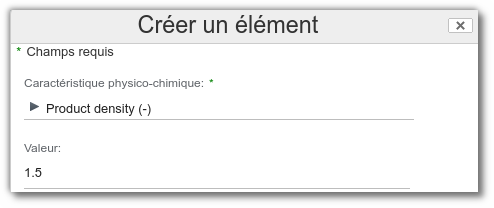
Press "Save" to save your form.
If the product associated with the product specifications does not meet the specified physico in the product specifications, an alert appears in the physicochemical list for the concerned physico.
An alert is also issued in the progress wheel. 
Forbidden Ingredients
Once the product specifications is open, go to the forbidden ingredient list.
This list allows setting the following levels of requirements:
- Requirement level: whether the ingredient is allowed, tolerated, forbidden or if it's simply information about the product;
- Message: a message that will be displayed when the product;
- Maximum value: maximum allowed threshold of the concerned ingredient by this form;
- forbidden GMOs: whether GMOs are forbidden or not;
- forbidden ionization: whether ionization is forbidden or not;
- Concerned ingredients: several can be selected;
- Geographical origins: for example, you may want to prohibit the use of ingredients from certain countries;
- Required geographical origins;
- Organic origin: for example, you may want to prohibit the use of ingredients from certain materials.
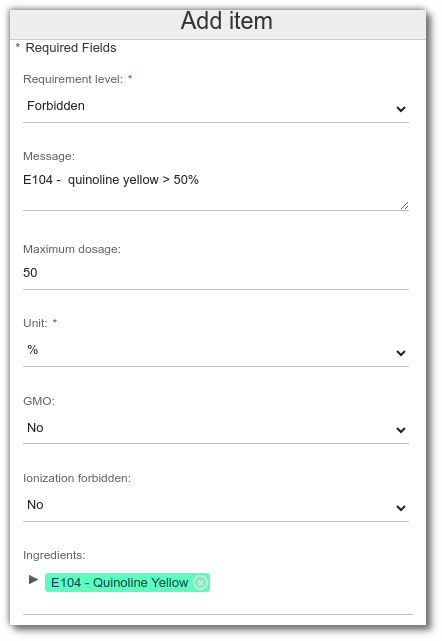
For tolerated and allowed requirement levels, note that it is essential to register a maximum value: 100%, otherwise the system will recognize all other ingredients as forbidden.

Units of forbidden Ingredients:
Three dosage units are available in the forbidden ingredients: %; mg/kg; mg/L.
This feature allows calculating the quantity of the ingredient usable in the finished product.
In this example, additive E104 is forbidden at a maximum dosage of 50%. In the ingredient list of the semi-finished product, a compliance column appears since the ingredient (E104 - quinoline yellow) is present at 100%.
The compliance column alerts that the product specifications TEST is not respected. It indicates that 50% of the semi-finished product is usable, to be compliant and respect the product specifications Test.

Labeling Rules
Before addressing this part, refer to the documentation Labeling Rules
To avoid having to create specific rules for each product or each product model, it is possible to define labeling rules valid in ALL cases.
Once the product specifications is open, go to the labeling rules list.
A form appears to name the product specifications. Fill it out and click on "Save". Go to the "Labeling Rule" list and click on "Add". A form allows completing the information related to a new labeling rule, namely:
- its name internally;
- its label;
- its expression, i.e., its formula;
- the components it concerns;
- the replacement component (if it is already in the product list);
- the rule type;
- the group concerned by the rule;
- the language;
- whether the rule is active or not (this avoids deleting a rule and having to recreate it later);
- whether the calculation is manual or not.
Note: to fill out the form correctly, refer to the chapter Labeling Rules. Then click on "Save" to save this new rule.
Thus, when creating a new product and generating its labeling, this rule will be applied automatically (if the entity concerned by the rule is in the product recipe).
Not compatible products
WARNING: Make sure to have the "Not compatible products" section displayed beforehand.
Once your forbidden ingredients are well defined, it can be tedious to determine if a particular RM/SF/FP is compatible with your product specifications. For this, there's the "Not compatible products" tab on your product specifications.
First, you need to choose the "Non-conforming" entities to consider. To do this, go to the "Properties" tab and fill in the "Compatibility test filter" field.
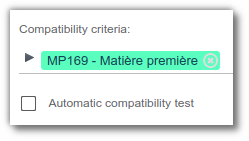
You can choose whichever entities you want, such as "Raw Material", "Finished Product", etc... and as many as you want.
In the example above, a rule has been created in the "forbidden Ingredients" list:

To apply the newly created rule, go to "Properties" and click the "reformulate" button.
Go to the "Incompatible Products" list, where all the RM betraying the rule set up in our example (maximum 1% water presence) are formulated.
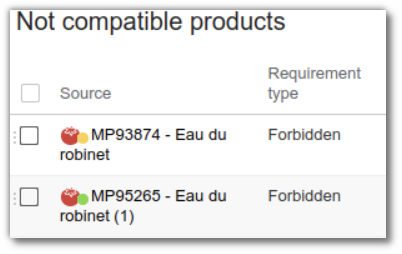
Of course, this tab takes into account prohibitions from other types, as mentioned earlier (geographical, biological, etc.).
Tips: This list includes a column "Requirement Details" that contains the message configured during the creation of the ingredient prohibition rule. It's important to include one to avoid any ambiguity regarding incompatible products. It's also recommended to create a separate rule for each prohibition to have a specific message for each prohibition. For example, for prohibitions like "No water" and "No wheat", it's better to have two separate rules with each having a specific message rather than a single rule combining both, which would make the message less precise.
Attention: The "Incompatible Products" list only considers prohibitions for which a maximum value (%) has been defined in the case of an ingredient prohibition. If you want to prohibit all products regardless of their proportion, you can specify "0". To disable an ingredient prohibition without deleting it, you can simply clear or leave empty its maximum value (%).
Associating a product with a product specifications:
Open the finished product > Edit properties > product specifications > select from the dropdown menu.
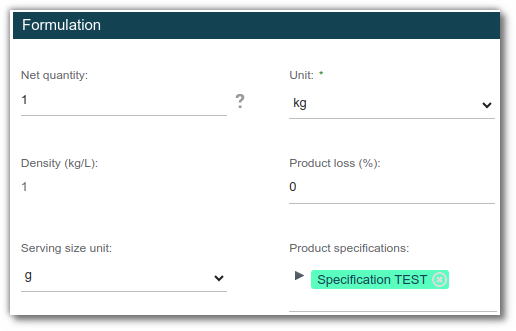 ```
```